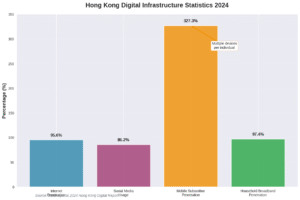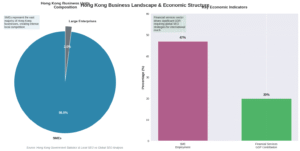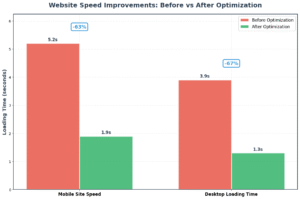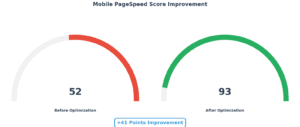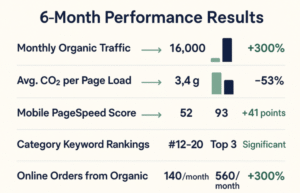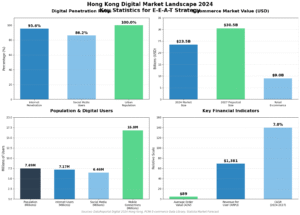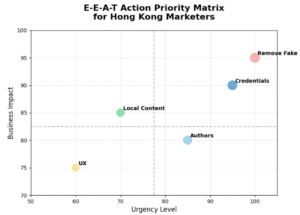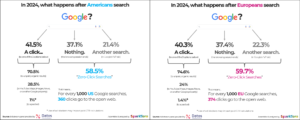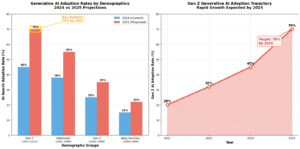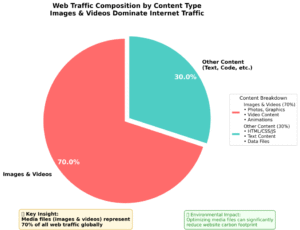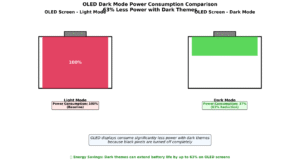Category: SEO
Local SEO vs. Global SEO: Hong Kong’s Unique Challenges
Sep 9, 2025 | 3 Min Read

Hong Kong businesses face unique challenges when choosing between local and global SEO. Local SEO is vital for small shops and services targeting nearby customers, requiring optimization in both English and Traditional Chinese, plus strong reviews and map visibility in a compact, competitive city. Global SEO matters for finance, tech, and e-commerce brands seeking international reach, demanding multilingual content, cultural adaptation, and technical setups like hreflang. Striking the right balance is key—brands must embrace Hong Kong’s bilingual market, engage local trust signals, and still prepare for cross-border visibility to stand out both locally and worldwide.
I.Introduction
Search engine optimization has evolved from a technical afterthought to a fundamental driver of business visibility and revenue generation. In an era where 99% of people have used the internet to look up information about a local business and 4 out of 5 users conduct searches with local intent, understanding the distinction between local and global SEO becomes crucial for sustainable growth.
The importance of this distinction is amplified in Hong Kong, where businesses must navigate a complex digital ecosystem that serves both hyperlocal consumers and international markets. According to DataReportal’s 2024 Hong Kong Digital Report, Hong Kong boasts an internet penetration rate of 95.6%, with 86.2% of the population active on social media platforms. This exceptional digital connectivity creates both opportunities and challenges for businesses seeking to establish their online presence.
Hong Kong’s unique position as a global financial hub with strong local characteristics presents a distinctive case study in SEO strategy. The territory serves as home to 78 of the top 100 banks in the world and maintains financial services representing over 20% of its $369-billion GDP. This combination of local market density and global significance requires businesses to carefully balance their SEO approaches to maximize both regional dominance and international reach.
II.Defining Local SEO vs. Global SEO
Local SEO: Targeting Geographic Specificity
Local SEO focuses on optimizing online presence to attract customers within specific geographic boundaries. This strategy prioritizes proximity, local relevance, and community-based trust signals to achieve visibility in location-based searches.
Key tactics for local SEO include:
Google Business Profile Optimization: According to BrightLocal’s research, 32% of SEO professionals believe that Google Business Profile is the most essential factor for ranking well in the local map pack
Localized Keywords: Targeting search terms that include geographic modifiers and local intent signals
Customer Reviews Management: With 90% of marketers believing that reviews directly impact local pack rankings
Local Citations and NAP Consistency: Ensuring consistent Name, Address, and Phone number across directories, as businesses with consistent NAP data are 40% more likely to appear in the local pack
Local Link Building: Acquiring backlinks from geographically relevant and authoritative local sources
Global SEO: Achieving International Reach
Global SEO encompasses strategies designed to reach audiences across multiple countries and regions, requiring a more complex approach to language, culture, and technical implementation.
Key tactics for global SEO include:
Multilingual Content Strategy: Creating content that resonates with diverse linguistic and cultural audiences
International Keyword Research: Understanding how search behavior varies across different markets and languages
Hreflang Implementation: Using HTML tags to signal to search engines which language and regional versions of pages to serve to specific audiences
Technical SEO Architecture: Implementing appropriate URL structures (ccTLDs, subdomains, or subdirectories) to organize international content
Cultural Adaptation: Ensuring content aligns with local customs, preferences, and regulatory requirements
The distinction between these approaches becomes particularly relevant when examining research from Manchester Metropolitan University, which found that local SEO recovery tends to be more difficult compared to overall major algorithm updates, due to the historical SEO practices attributed to many small business websites.
III. Hong Kong’s Unique Digital Landscape
Exceptional Digital Infrastructure
Hong Kong’s digital infrastructure represents one of the most advanced in the world. The territory maintains a 97.4% household broadband penetration rate and boasts mobile subscriber penetration of 327.3%, indicating multiple device ownership per individual. This exceptional connectivity creates a highly competitive digital environment where businesses must optimize for multiple touchpoints and platforms.
The mobile-first nature of Hong Kong’s digital consumption is particularly significant, with 30% of all mobile searches being location-related and 88% of consumers who conduct local searches on smartphones visiting or calling stores within 24 hours.
Multilingual Complexity
Hong Kong’s linguistic diversity presents unprecedented challenges for SEO practitioners. The territory operates with three primary languages:
Cantonese: The dominant spoken language, used by approximately 96% of the population
English: The business and legal language, with 53.1% of Hong Kong residents being proficient
Mandarin: Growing in importance, with 48.6% of residents being proficient
This trilingual environment requires businesses to make strategic decisions about language targeting, with research indicating that employers view multilingual capabilities as essential for business success in Hong Kong’s competitive market.
Dense Market Competition
Hong Kong’s compact geography creates an intensely competitive business environment. With Small and Medium Enterprises (SMEs) accounting for 98% of total business units and 47% of total employment, businesses face significant challenges in establishing digital differentiation.
The territory’s 1,104 square kilometers house over 7.49 million residents, creating one of the world’s highest business density ratios. This concentration means that local SEO competition is exceptionally fierce, with businesses competing not just against direct competitors but also against international brands targeting the Hong Kong market.
Platform Preferences and Digital Behavior
Hong Kong users demonstrate distinct platform preferences that impact SEO strategy:
Google Dominance: 88% of people use Google Maps to find local businesses, compared to only 12% using Apple Maps
Social Media Integration: With 86.6% social media usage and users spending an average of 1.7 hours daily across platforms
Mobile-Centric Behavior: 84% of local searches conducted on mobile devices, emphasizing the importance of mobile optimization
IV.Challenges of Local SEO in Hong Kong
Language Barriers and Multilingual Optimization
The necessity to optimize for multiple languages simultaneously creates complex technical and strategic challenges. According to Digitas Hong Kong, businesses must “think about multilingual SEO” and create content in both English and Cantonese to reach their complete audience.
This multilingual requirement extends beyond simple translation. Search behavior patterns differ significantly between languages, with Cantonese speakers often using different query structures compared to English or Mandarin speakers. The challenge is compounded by the need to understand cultural nuances that affect keyword selection and content creation.
Research from academic studies on multilingual SEO indicates that effective multilingual optimization requires understanding the linguistic behavior of users across different languages, as search patterns and preferred terminology can vary dramatically.
Intense Local Competition
Hong Kong’s concentrated market creates unprecedented competitive pressure. With businesses competing within a limited geographic area, achieving local SEO differentiation becomes increasingly challenging. The territory’s high business density means that:
Keyword Competition: Popular local search terms face intense bidding competition
Review Dominance: Businesses must maintain exceptional review scores, as 89% of consumers are more likely to choose businesses that respond to all reviews
Local Pack Visibility: With only three positions available in Google’s local pack, achieving visibility requires exceptional optimization
Local Trust Factors and Social Proof
Hong Kong consumers demonstrate particularly high expectations for local business credibility. Research indicates that 62% of consumers will avoid a local business if they find incorrect information online, making accuracy and consistency critical success factors.
The importance of review management is amplified in Hong Kong’s competitive environment. Businesses must not only generate positive reviews but also demonstrate active engagement with customer feedback. Studies show that 75% of consumers always or often check online reviews when researching local businesses, making reputation management a critical component of local SEO success.
Geographic Density vs. Demographic Diversity
Despite its compact size, Hong Kong encompasses remarkable demographic diversity. The territory serves multiple distinct communities, each with different search behaviors, language preferences, and cultural expectations. This diversity requires businesses to:
Segment Local Audiences: Develop distinct approaches for different demographic groups
Cultural Sensitivity: Ensure content resonates across cultural boundaries while maintaining local relevance
Micro-Location Targeting: Optimize for specific districts or neighborhoods within Hong Kong
V.Challenges of Global SEO from Hong Kong
Cross-border Competition Intensity
Hong Kong businesses pursuing global SEO face competition from both Mainland Chinese companies and established international brands. This creates a three-way competitive dynamic that requires sophisticated positioning and differentiation strategies.
The challenge is exemplified by Airwallex’s international SEO approach, where the FinTech company had to establish distinct regional content strategies across multiple markets while maintaining consistent brand positioning. Their approach included creating country-specific subfolders, with specialized content for Australia, the United States, the United Kingdom, and Hong Kong markets.
Cultural Adaptation Complexity
Global SEO from Hong Kong requires deep understanding of target market cultures, regulations, and business practices. This extends beyond language translation to encompass:
Regulatory Compliance: Understanding data privacy laws, financial regulations, and business requirements across jurisdictions
Cultural Preferences: Adapting content to align with local customs and expectations
Business Practices: Modifying approaches to match local business etiquette and decision-making processes
Technical SEO Implementation Challenges
Implementing global SEO presents significant technical challenges, particularly in:
Hreflang Implementation: Research from Seer Interactive indicates that proper hreflang implementation is critical for international success, yet remains one of the most challenging aspects of global SEO. Hong Kong businesses must ensure proper language and region targeting across their international presence.
Domain Strategy Decisions: Choosing between country-code top-level domains (ccTLDs), subdomains, and subdirectories significantly impacts SEO performance. Search Engine Journal research suggests that each approach has distinct advantages and limitations that must be carefully considered.
Site Architecture Complexity: Managing multilingual, multi-regional websites requires sophisticated technical infrastructure to ensure proper crawling, indexing, and user experience across different markets.
Regulatory and Compliance Considerations
Global expansion requires navigation of complex regulatory environments. Hong Kong businesses must ensure compliance with:
Data Privacy Regulations: Including GDPR in Europe, various state privacy laws in the United States, and emerging privacy regulations across Asia-Pacific markets
Financial Services Regulations: Particularly relevant for Hong Kong’s significant FinTech sector
Content Restrictions: Understanding content limitations and cultural sensitivities across target markets
VI.Strategies to Balance Local and Global SEO
Integrated Keyword Research Strategy
Successful Hong Kong businesses develop comprehensive keyword strategies that address both local and international audiences. This involves:
Local Keyword Optimization: Targeting Cantonese, English, and Mandarin search terms with Hong Kong-specific modifiers and intent signals.
Global Keyword Expansion: Identifying high-value international keywords while understanding regional search behavior variations.
Cross-Language Keyword Mapping: Developing content strategies that address the same topics across multiple languages while avoiding duplicate content penalties.
Google Business Profile Excellence
Optimizing Google Business Profile becomes critical for Hong Kong businesses targeting local audiences. Key strategies include:
Complete Profile Information: Ensuring all business details are accurate and comprehensive, as businesses with complete profiles are 50% more likely to be considered for purchases
Multilingual Descriptions: Creating business descriptions that serve both local and international audiences
Regular Content Updates: Maintaining active profiles with fresh content, photos, and customer interactions
Multilingual Content Architecture
Developing content that serves both local and global audiences requires sophisticated planning:
Content Localization: Moving beyond translation to create culturally relevant content for each target market.
Schema Markup Implementation: Using structured data to help search engines understand content context across languages and regions.
Internal Linking Strategy: Creating logical content relationships that support both local and international SEO objectives.
Strategic Partnership and Link Building
Hong Kong businesses benefit from developing both local and international link building strategies:
Local Partnerships: Collaborating with Hong Kong-based organizations, industry associations, and complementary businesses to build local authority.
International Outreach: Developing relationships with global industry publications, international business directories, and relevant international organizations.
Cross-Border Collaboration: Partnering with businesses in target international markets to develop mutually beneficial link exchanges and content collaborations.
Analytics and Performance Differentiation
Successful businesses implement analytics strategies that clearly differentiate between local and international performance:
Segmented Reporting: Creating distinct analytics views for local Hong Kong traffic versus international visitors.
Conversion Tracking: Understanding how local versus international visitors behave differently and optimizing accordingly.
Market-Specific KPIs: Developing performance indicators that reflect the unique characteristics of each target market.
VIII. Conclusion
The distinction between local and global SEO approaches represents far more than a strategic choice—it defines how businesses connect with their audiences in an increasingly connected yet locally relevant digital landscape. For Hong Kong businesses, this decision carries particular weight given the territory’s unique position as a global financial hub with distinct local characteristics.
Businesses operating in Hong Kong stand at a unique crossroads where local expertise and global ambition intersect. Success requires not just understanding the technical distinctions between local and global SEO, but embracing the cultural intelligence, technical sophistication, and strategic patience necessary to excel in both domains. Those who master this balance will find themselves uniquely positioned to capture the opportunities that emerge from Hong Kong’s distinctive role in the global digital economy.
The future belongs to Hong Kong businesses that can think locally while acting globally, creating digital presences that honor local community relationships while embracing the limitless possibilities of international expansion. In this dynamic environment, SEO becomes not just a marketing tactic, but a fundamental capability that enables businesses to build bridges between local relevance and global impact.
If you’d like to explore sustainable SEO solutions tailored to your business, feel free to reach out to us here.
References
- BrightLocal. (2024). Google’s Local Algorithm and Local Ranking Factors.
- DataReportal. (2024). Digital 2024: Hong Kong — Global Digital Insights.
- Digitas Hong Kong. (2025). Successful SEO Campaign in 2025: Your Guide to SEO.
- Foundation Inc. (2024). Airwallex Rides International SEO Strategy to $5.5B Valuation.
- Keegan, B., & Taylor, J. (2019). Are you local? The challenges of local search engine optimisation strategies. The Journal of Digital and Social Media Marketing, 7(3), 270-280.
- Search Engine Journal. (2018). The Best Practices of Optimizing for International SEO.
- SeoProfy. (2025). 76 Local SEO Statistics for 2025.
- Seer Interactive. (2023). International SEO Hreflang Guide.
- The Visual Realm. (2025). Local SEO: How Reviews Drive Rankings in 2025.
- WhiteSpark. (2023). Local Search Ranking Factors Survey.
Case Study: How We Grew a Hong Kong FMCG E-commerce Brand’s Traffic by 300% with Green SEO
Aug 15, 2025 | 3 Min Read

Client Overview
Business Type: E-commerce store specializing in premium bottled teas and healthy beverages
Industry: FMCG (Fast-Moving Consumer Goods) – Food & Beverage
Market: Hong Kong & Macau
The Challenge
Our client, a well-established Hong Kong beverage brand, faced a significant digital transformation challenge. Despite having strong offline retail distribution across major supermarket chains and convenience stores in Hong Kong and Macau, their online presence was virtually non-existent.
The brand’s e-commerce website suffered from multiple critical issues:
- Poor search visibility:The site ranked poorly for both branded keywords and essential category terms
- Technical performance issues:Slow loading speeds that frustrated potential customers
- High carbon footprint:Heavy media content and inefficient hosting created environmental concerns
- Missed opportunities: Low organic traffic meant they were losing potential sales to competitors
This disconnect between their strong offline presence and weak digital performance was particularly problematic in a post-pandemic market where Hong Kong consumers increasingly turned to online shopping for everyday essentials.
Strategic Objectives
Our comprehensive Green SEO strategy focused on three primary objectives:
- Drive Revenue Growth:Increase organic e-commerce traffic and convert visitors into paying customers
- Environmental Alignment:Reduce website carbon emissions to support the brand’s sustainability positioning in the competitive FMCG market
- Market Capture:Dominate search demand for relevant FMCG category keywords in the Hong Kong market
Our Revolutionary Green SEO Approach
Phase 1: Carbon & Technical Audit
We began with a comprehensive environmental and technical assessment of the existing website infrastructure:
Carbon Footprint Analysis:
- Initial measurement revealed 3.4g CO₂ per page load—significantly above sustainable benchmarks (ideal: <1.8g CO₂)
- Identified major emission sources: uncompressed product images, redundant JavaScript libraries, and energy-intensive hosting
Technical Performance Assessment:
- Mobile site speed: 5.2 seconds (well above Google’s recommended 3-second threshold)
- Desktop loading time: 3.9 seconds
- Multiple render-blocking resources affecting user experience
- Outdated hosting infrastructure lacking optimization
Phase 2: Sustainable Site Optimization
Green Infrastructure Migration:
Transitioned to renewable energy-powered hosting with certified green credentials
Implemented Content Delivery Network (CDN) with global edge locations to reduce data transfer distances
Performance Optimization:
- Image Optimization: Compressed product images using next-generation WebP format, reducing file sizes by an average of 67%
- Lazy Loading Implementation: Deployed progressive image loading to reduce initial page weight
- Code Optimization: Minified CSS, JavaScript, and HTML, eliminating unused code libraries
- Results: Overall page weight reduction of 47%
Speed Improvements:
- Mobile site speed: 5.2s → 1.9s (63% improvement)
- Desktop loading time: 3.9s → 1.3s (67% improvement)
- Mobile PageSpeed Score: 52 → 93 (+41 points)
Phase 3: FMCG-Focused SEO Content Strategy
Category Landing Pages: We developed targeted landing pages optimized for high-commercial-intent keywords:
- “Low sugar iced tea Hong Kong”
- “Organic bottled drinks Hong Kong”
- “Premium tea brands Hong Kong”
- “Healthy beverages delivery HK”
Product Page Enhancement:
- Added comprehensive FAQ sections addressing common customer concerns
- Implemented structured data markup for rich snippets
- Optimized product descriptions with location-specific keywords
Content Marketing: Published authoritative blog content linking beverages to Hong Kong lifestyle trends:
- “Best Summer Drinks for Hong Kong’s Humid Climate”
- “Sustainable Packaging Trends in Hong Kong FMCG”
- “Office Wellness: Healthy Beverage Choices for Hong Kong Professionals”
Phase 4: Green Link-Building & PR Strategy
Innovative Green Link Assessment: We utilized our proprietary GreenSEO tool to identify backlink opportunities based on sustainability metrics:
- Green Score: Measured target websites’ carbon efficiency and renewable energy usage
- ELS (Eco Linked Score): Our composite metric combining Green Score, Link Trust Score, and Link Relevance Score
- Sustainable Partner Selection: Prioritized collaborations with environmentally conscious Hong Kong lifestyle blogs, sustainable living websites, and eco-friendly business directories
Strategic Partnerships:
- Collaborated with Hong Kong environmental organizations
- Secured features in sustainable lifestyle publications
- Participated in green business directories and certifications
Key Strategic Takeaways
1. Values Alignment Drives Customer Acquisition
The Green SEO approach perfectly aligned with the brand’s sustainability values, attracting environmentally conscious Hong Kong consumers who prioritize eco-friendly purchasing decisions. This values-based marketing approach resulted in higher customer loyalty and increased average order values.
2. Local + Category SEO Maximizes FMCG Success
The combination of FMCG category keywords with precise Hong Kong location targeting proved highly effective in capturing high-commercial-intent traffic. Local consumers searching for specific beverage categories found our client’s products at the exact moment of purchase consideration.
3. Technical Optimization Drives Both Rankings and Conversions
The comprehensive technical improvements didn’t just boost search rankings—they created a superior user experience that significantly improved conversion rates and customer satisfaction.
4. Sustainable Practices Offer Competitive Advantage
In Hong Kong’s competitive FMCG market, the commitment to environmental responsibility became a key differentiator, attracting press coverage and customer loyalty that traditional SEO approaches couldn’t achieve.
Conclusion
For this Hong Kong FMCG e-commerce brand, our innovative Green SEO approach delivered extraordinary results across all key performance indicators:
- Revenue Growth: 300% increase in organic traffic and online orders
- Environmental Impact: 53% reduction in website carbon footprint
- Market Position: Established category authority in competitive Hong Kong beverage market
- Brand Trust: Enhanced reputation through authentic sustainability commitment
This case study demonstrates that Green SEO isn’t just an environmental initiative—it’s a powerful business strategy that delivers measurable growth while building long-term brand trust and market authority.
The success of this campaign proves that sustainable digital marketing practices can drive significant business results while supporting broader environmental goals, creating a win-win scenario for businesses, customers, and the planet.
If you’d like to explore how Green SEO strategies can boost your brand’s growth, feel free to get in touch with us here.
Note:
The statistics in this case study are indicators because of data security and privacy protection
Google’s 2025 E-E-A-T Update: What Hong Kong Marketers Must Do
Aug 13, 2025 | 3 Min Read

1. Introduction
Google’s January 2025 update to the Search Quality Rater Guidelines marks the most significant revision to E-E-A-T (Experience, Expertise, Authoritativeness, Trustworthiness) evaluation criteria since March 2024. This comprehensive 181-page update fundamentally reshapes how Google assesses content quality, introducing stricter criteria for authenticity and more granular detection of deceptive practices.
E-E-A-T has evolved from a simple content quality framework to Google’s primary weapon against the proliferation of AI-generated content and manipulative SEO tactics. The framework, which added “Experience” to the original E-A-T model in December 2022, now serves as the foundation for Google’s core ranking systems that prioritize “helpful, reliable, people-first content” over content created primarily to manipulate search rankings.
For Hong Kong marketers, this update carries particular significance. Operating in one of Asia’s most competitive digital markets—where cross-border e-commerce represents 56% of total online transactions and the average revenue per user reaches US$1,381—local businesses face unique challenges that make E-E-A-T compliance both critical and complex. Hong Kong’s position as a global trade hub, combined with its tech-savvy population (95.6% internet penetration) and multilingual market dynamics, requires marketers to demonstrate authenticity across cultural and linguistic boundaries while competing against both local and international players.
2. What’s New in the 2025 E-E-A-T Update?
Enhanced Deception Detection Framework
Google’s 2025 update introduces an expanded definition of “deceptive purpose” that extends far beyond traditional misinformation. The new guidelines specifically target three key areas of deception that have become increasingly prevalent:
Fake E-E-A-T Content: The update introduces unprecedented scrutiny of artificial authority signals. Google now explicitly identifies and penalizes:
Websites claiming physical “brick and mortar” stores when operating purely online
AI-generated author profiles with fabricated credentials and AI-generated photos
False claims of professional expertise, such as unqualified individuals posing as medical professionals
Deceptive Business Information: The guidelines now target businesses that misrepresent their operational reality, including fake physical addresses, manufactured company histories, and artificially inflated credentials.
Manipulative Design Elements: Google has expanded its focus on user interface deception, including buttons designed to mislead users (such as fake “close” buttons that trigger downloads) and misleading page titles that don’t match content.
Algorithmic Integration Signals
The update suggests Google’s algorithms are becoming more sophisticated at detecting these deceptive practices automatically. Marie Haynes, a leading SEO authority, notes in her analysis of the January 2025 guidelines that Google has introduced specific guidance on “scaled content abuse” and AI-generated content with fabricated authorship—indicating that algorithmic detection of these issues is now possible at scale.
Trust-First Evaluation Model
The 2025 update reinforces that “trust is most important” among the four E-E-A-T factors. This represents a shift from expertise-heavy evaluation to trust-centric assessment, where content lacking appropriate E-E-A-T for its purpose automatically receives a “Low” quality rating, regardless of other positive factors.
3. The Impact on Hong Kong’s Digital Landscape
Market Characteristics and Competitive Dynamics
Hong Kong’s digital ecosystem presents unique challenges that make E-E-A-T compliance particularly critical:
High-Value, Competitive Market: With an e-commerce market projected to reach US$23.5 billion in 2024 and growing at a 7% CAGR through 2027, Hong Kong represents one of Asia’s most lucrative digital markets. The average order value of US$89 indicates sophisticated consumers with high expectations for content quality and brand authenticity.
Cross-Border Complexity: Cross-border transactions representing 56% of Hong Kong’s e-commerce create unique E-E-A-T challenges. Local businesses must demonstrate expertise and trustworthiness to consumers who regularly interact with international brands like Taobao (20.9% market share) and Amazon (11% market share).
Multilingual and Multicultural Audience: Hong Kong’s diverse population requires content that demonstrates cultural expertise while maintaining authoritativeness across different linguistic contexts. This complexity makes fake or generic content more easily detectable and less effective.
Immediate Ranking Impact Scenarios
Based on the new guidelines, Hong Kong businesses in several categories face immediate ranking risks:
Financial Services: Hong Kong’s position as a global financial hub means YMYL (Your Money or Your Life) content faces the highest E-E-A-T standards. Financial advisors, investment platforms, and banking services without clear professional credentials and transparent business operations risk significant ranking drops.
E-commerce and Retail: With 41% of Hong Kong consumers purchasing clothing/accessories online and 37% booking travel, retail businesses using AI-generated product descriptions without clear human oversight, or fake customer reviews, face potential algorithmic penalties.
Health and Wellness: Healthcare-related businesses—particularly those serving Hong Kong’s aging population (21.9% aged 65+)—must demonstrate clear medical expertise and avoid any misrepresentation of qualifications.
4. What Marketers Must Do Right Now
a. Prioritize Authentic Experience
Implement First-Hand Experience Documentation:
- Create detailed process documentation showing how products are tested, reviewed, or used
- Include behind-the-scenes content that demonstrates genuine interaction with products/services
- For restaurants: Show cooking processes, ingredient sourcing, chef interactions
- For retail: Document product testing, quality assessment, customer service processes
Leverage Hong Kong-Specific Local Knowledge:
- Demonstrate understanding of local consumer preferences (e.g., mobile payment preferences—45% digital wallet usage)
- Show awareness of Hong Kong’s unique regulatory environment
- Reference local events, culture, and market conditions in content
Visual Experience Proof:
- Include authentic photos of your Hong Kong operations, team, and facilities
- Avoid stock photography for key business representations
- Create video content showing real employees and genuine business operations
b. Demonstrate Expertise and Authority
Professional Credential Verification:
- Ensure all claimed credentials are easily verifiable through external sources
- Link to professional associations, certifications, and educational backgrounds
- For YMYL topics, provide clear medical, financial, or legal qualification evidence
Industry Recognition Building:
- Secure mentions in reputable Hong Kong business publications (South China Morning Post, Hong Kong Business Magazine)
- Participate in local industry associations and events
- Develop relationships with Hong Kong media outlets for authentic coverage
Content Depth and Originality:
- Move beyond surface-level information to provide insights unavailable elsewhere
- Reference specific Hong Kong market data and trends
- Offer unique perspectives based on local market experience
c. Build and Maintain Trust
Transparent Business Information:
- Ensure accurate business registration details are publicly available
- Provide clear contact information, including verified Hong Kong addresses and phone numbers
- Maintain consistent business information across all online platforms
Customer Verification Systems:
- Implement verified review systems that prevent fake testimonials
- Display genuine customer feedback, including negative reviews when appropriate
- Use structured data markup to help Google identify authentic reviews
Clear Privacy and Data Handling:
- Publish comprehensive privacy policies compliant with Hong Kong’s Personal Data (Privacy) Ordinance
- Explain data collection and usage practices clearly
- Provide easy contact methods for privacy concerns
d. Optimize for Local Relevance
Hong Kong Search Behavior Adaptation:
- Optimize for local search patterns (89.4% internet penetration creates sophisticated search behaviors)
- Create content addressing Hong Kong-specific consumer pain points
- Develop FAQ sections addressing local concerns (shipping, customs, local regulations)
Multi-Language Strategy:
- Ensure content accuracy across Traditional Chinese and English versions
- Avoid machine translation without human oversight
- Demonstrate cultural understanding in language choices and content presentation
Local Business Integration:
- Participate in Hong Kong’s local business ecosystem
- Engage with local suppliers, partners, and service providers
- Show integration with Hong Kong’s business community
e. Continuous Content Quality Improvement
Regular Content Auditing:
- Implement monthly reviews of high-traffic content for accuracy and freshness
- Remove or significantly update outdated information
- Monitor competitor content quality improvements
Human Oversight Implementation:
- Ensure all AI-generated content receives human review and editing
- Implement editorial processes that verify claims and sources
- Create content creation guidelines that prioritize authentic expertise
6. Conclusion
Google’s 2025 E-E-A-T update represents a fundamental shift from content optimization to authenticity verification. For Hong Kong marketers operating in one of Asia’s most competitive and sophisticated digital markets, this change demands immediate strategic realignment.
The territory’s unique characteristics—high internet penetration (95.6%), sophisticated consumers (US$1,381 average revenue per user), and complex cross-border commerce dynamics—make E-E-A-T compliance both more challenging and more critical than in most other markets. The 56% cross-border transaction rate means Hong Kong businesses compete not just locally but against international players with established authority signals.
Success in the post-2025 E-E-A-T environment requires Hong Kong marketers to move beyond traditional SEO tactics toward genuine business authenticity. This means investing in verifiable expertise, transparent operations, and authentic local market integration rather than seeking ranking shortcuts.
The businesses that will thrive are those that view E-E-A-T not as an SEO compliance requirement but as a framework for building genuine competitive advantages in Hong Kong’s discerning digital marketplace. By prioritizing authentic experience, demonstrable expertise, verifiable authority, and transparent trustworthiness, Hong Kong marketers can not only comply with Google’s evolving requirements but also build sustainable competitive positions in one of the world’s most dynamic digital economies.
The time for reactive compliance has passed. Hong Kong marketers must now proactively build authentic digital presence that serves both algorithmic requirements and genuine consumer needs in this increasingly sophisticated market.
Curious about google SEO and digital marketing? Don’t miss my course“Big Data and Artificial Intelligence Marketing” — it’s designed to help you put ideas into action.
References:
- Google. (2024, November 23). Creating helpful, reliable, people-first content. Google Developers.
- Broadley, C. (2025, May 5). Google’s updated raters guidelines target fake EEAT content – Analysis of January 2025 Quality Rater Guidelines update. Search Engine Journal.
- Raptive. (2025, March 21). How to improve content quality according to Google’s latest Search Quality Rater Guidelines – Expert analysis of 2025 guidelines changes and practical implementation strategies. Raptive Resources.
- DataReportal. (2024, February 21). Digital 2024: Hong Kong. DataReportal.
- PCMI Payments & Commerce Market Intelligence. (n.d.). The evolution of Hong Kong’s e-commerce market. PCMI.
- Tucker, E. (2022, December 15). Our latest update to the quality rater guidelines: E-A-T gets an extra E for Experience. Google Search Central Blog.
- Single Grain. (2025, April 27). E-E-A-T strategies that guarantee Google’s trust in 2025. Single Grain.
Why Firms Should Focus on GEO Along with SEO
Aug 5, 2025 | 3 Min Read

1.Introduction
The digital landscape is undergoing a profound transformation with the rise of artificial intelligence in search technology. Search Engine Optimization (SEO) has long been the cornerstone of online visibility, helping websites climb rankings on platforms like Google and Bing. However, a new paradigm is emerging—Generative Engine Optimization (GEO), which focuses on optimizing content for AI-driven search engines that generate direct answers rather than simply listing websites.
SEO is the traditional practice of optimizing website content to rank higher in search engine results pages (SERPs) through strategies like keyword optimization, backlink building, and technical website improvements. In contrast, GEO is the emerging practice of structuring content so that AI-driven engines like ChatGPT, Perplexity, Gemini, or Bing Chat cite, summarize, or link to your brand in their AI-generated responses.
This transformation is happening rapidly. Current research shows 58.5% of US Google searches and 59.7% of EU searches end in zero-click experiences. Meanwhile, generative AI adoption doubled to 65% in 2024, with Google’s AI Overviews appearing on 86.83% of search queries, fundamentally reshaping digital visibility strategies.
As businesses navigate this evolving search landscape, understanding the differences between SEO and GEO—and developing strategies that leverage both—will be critical to maintaining online visibility and driving customer engagement.
2.Differences Between SEO and GEO
Traditional Search Engine Algorithms vs. Generative AI Engines
Traditional search engines like Google use algorithms focused primarily on ranking websites based on factors such as keyword relevance, backlink quality, and user engagement metrics. These engines present users with a list of links to websites that might answer their query, requiring users to click through and extract the information they need.
Generative AI engines, on the other hand, leverage large language models (LLMs) to directly synthesize answers from multiple sources. As the arXiv paper “GEO: Generative Engine Optimization” explains: “While widely used for Search Engine Optimization, we find that traditional SEO methods are not directly applicable to Generative Engines. This is because, unlike traditional search engines, the generative model in generative engines is not limited to simple keyword matching” arXiv.
These fundamental differences in technology create very different landscapes for optimization:
Changes in User Intent and Content Discovery
User behavior and expectations are also changing dramatically. Traditional search engines trained users to scan through lists of results and click on multiple options until they found what they needed. Generative search engines are training users to expect immediate, comprehensive answers without leaving the search interface.
“Unlike SEO, which tries to earn a click, GEO is about becoming the answer. SEO focuses on visibility. GEO focuses on influence,” notes ePublishing.
This shift has major implications for content discovery. In the SEO-dominated world, users discovered content primarily by clicking through from search results. In the GEO-dominated world, users may never visit a website but will still consume its content through AI-generated summaries and citations.
3.Importance of GEO
Visibility in AI-Generated Answers and Summaries
As AI platforms increasingly mediate the relationship between users and content, visibility within AI-generated answers becomes crucial. When a user asks a question to ChatGPT or uses Google’s AI Overview feature, only a handful of sources get cited in the response—making this new “position zero” the prime digital real estate.
Research demonstrates that GEO methods can significantly improve this visibility. According to the arXiv study, “We demonstrate that our proposed Generative Engine Optimization methods can boost visibility by up to 40% on diverse queries” arXiv.
For businesses, this means that without effective GEO strategies, their content may become invisible to users even if they rank well in traditional search, as users increasingly bypass traditional search results in favor of AI-generated answers.
GEO’s Influence on Brand Authority and Trust
When an AI system cites a brand as a source in its generated response, it implicitly confers authority and trustworthiness to that source. This represents a fundamental shift in how authority is established online.
In traditional SEO, users might judge a website’s credibility after clicking through, based on design, content quality, and other factors. In AI-mediated search, the very fact that an AI platform has selected a source to cite becomes a powerful signal of credibility to users.
As Connected Markets notes, “For e-commerce, success hinges on product discoverability and trust. As consumers increasingly rely on AI assistants to recommend products, brands must ensure their offerings are not only visible but also accurately described” Zen Agency.
Reaching New Audiences Through AI Content Channels
GEO opens up entirely new channels for reaching audiences who may never encounter traditional search results. As voice assistants, AI chatbots, and other AI-powered interfaces become more prevalent, optimizing for these platforms becomes essential for comprehensive digital reach.
Data shows that different demographic groups are adopting AI search at different rates, with 70% of Gen Z expected to use generative AI by 2025 Zen Agency. By implementing strong GEO strategies, businesses can connect with these audiences through the technologies they prefer to use.
4.Synergy: GEO and SEO
Creating a Comprehensive Digital Presence
Rather than viewing SEO and GEO as competing strategies, forward-thinking companies are recognizing the synergy between them. Together, they create a comprehensive digital presence that captures visibility across both traditional and AI-powered search interfaces.
Foundation Inc. explains this complementary relationship: “The worlds of SEO and GEO are not mutually exclusive but complementary. Understanding the nuances between these two strategies is crucial for anyone looking to maximize their online visibility” Foundation Inc.
Businesses that focus exclusively on one approach risk missing significant portions of their potential audience. Case studies demonstrate that abandoning traditional SEO entirely for GEO often leads to overall traffic decline, as Google still remains the dominant traffic source for many businesses Zen Agency.
Leveraging Data from Both Approaches
One of the most powerful aspects of implementing both SEO and GEO strategies is the ability to leverage data from both approaches to enhance overall content optimization.
SEO data provides insights into user queries, click patterns, and engagement metrics. GEO data reveals how AI systems interpret and cite content, which sources they consider authoritative, and which content formats perform best in generated responses.
By analyzing both data sets together, businesses can identify:
- Content gaps that need to be addressed
- Topics where they have authority in traditional search but are missing from AI responses
- Opportunities to restructure existing content for better AI visibility
- New content types that could perform well across both channels
Future-Proofing Marketing Efforts
Perhaps most importantly, implementing both SEO and GEO strategies helps businesses future-proof their marketing efforts as the search landscape continues to evolve.
“Complementing your SEO with GEO future-proofs your strategy to better adapt to digital advancements, solidifying your brand’s presence and visibility” Ansira.
The balance between traditional and AI-powered search will likely continue to shift in the coming years. By maintaining expertise in both areas, businesses can adapt quickly to these changes without sacrificing visibility in either channel.
5.Implementation Considerations
Adapting Content for Generative Engines
Successfully optimizing for generative engines requires specific content adaptations beyond traditional SEO practices:
- Direct Answer Format:AI tools prioritize user intent. Content should be structured with titles, headers, and introductions that match real search phrasing and user intent Growth Marketing Pro.
- Citation Optimization:Strategically incorporating references from authoritative and credible sources significantly increases content’s trustworthiness in the eyes of AI systems Foundation Inc.
- Statistical Integration:Embedding relevant data points within content provides concrete evidence that supports the information, making it more likely to be cited by AI engines seeking factual support Foundation Inc.
- Schema Markup:Implementing comprehensive schema markup helps AI systems better understand and contextualize content, establishing clear relationships between entities and concepts Zen Agency.
- Content Freshness:AI uses signals such as publish date and frequency of updates to prioritize data used to generate answers, making regular content updates essential Improvado.
Real-world case studies demonstrate the effectiveness of these approaches. A mid-sized fashion retailer implemented a comprehensive GEO strategy focusing on structured product data and detailed FAQ content, resulting in a 32% increase in AI-referred traffic within three months Zen Agency.
Monitoring Performance Across Platforms
Tracking performance across both traditional search and AI platforms requires new measurement frameworks and tools:
Key GEO KPIs to Monitor:
- Keyword and Brand Visibility:Tracking how often your brand is cited as a source in AI-generated responses.
- AI Search Engine Referral:Monitoring traffic from AI-driven search platforms, which requires specialized tracking since “AI traffic often gets misclassified in analytics, appearing as ‘Direct’ traffic or mixed with other ‘Referral’ traffic” Empathy First Media.
- AI Overviews:Understanding how often your content appears in AI overviews that summarize content directly in search results.
- On-Site Engagement Metrics:Comparing engagement metrics for AI-sourced visitors versus traditional search visitors.
- Conversions, Leads & Revenue:Setting up goal tracking to attribute conversions to AI-generated traffic.
- Content Authority:Monitoring domain authority and external links as indicators of how AI engines might perceive your content’s reliability Obility B2B.
Implementing server-level tracking is crucial for capturing AI crawler interactions, as traditional JavaScript-based analytics miss these visits entirely Salesforce.
6.Conclusion
The digital search landscape is undergoing a fundamental transformation with the rise of AI-powered search interfaces. While SEO remains essential for visibility in traditional search engines, GEO is rapidly becoming equally important for ensuring content is discovered, cited, and trusted in AI-generated responses.
The most successful digital strategies will leverage both approaches, creating content that performs well across all search interfaces while implementing the technical optimizations required by each platform. This comprehensive approach ensures maximum visibility, regardless of how users choose to search.
As the distribution of search volume continues to shift between traditional and AI-powered interfaces, businesses that have invested in both SEO and GEO will be best positioned to maintain consistent visibility and engagement. The future belongs to those who recognize that these strategies are not competing approaches but complementary components of a holistic digital presence.
By starting GEO implementation now—while maintaining strong SEO practices—firms can future-proof their digital strategy and ensure their content remains discoverable, regardless of how search technology evolves in the coming years.
References:
- 1.Aggarwal, P., Murahari, V., Rajpurohit, T., Kalyan, A., Narasimhan, K., & Deshpande, A. (2024). GEO: Generative Engine Optimization. arXiv.
- 2.Sharma, A., & Dhiman, M.P. The Impact of AI-Powered Search on SEO: The Emergence of Answer Engine Optimization. ResearchGate.
- 3.SEO.AI (2025). Generative Engine Optimization (GEO) vs Search Engine Optimization (SEO).
- 4.Foundation Inc. SEO vs GEO: Search Engine Optimization vs Generative Engine Optimization.
- 5.ePublishing (2025). SEO vs GEO: What Is Generative Engine Optimization and Why It Matters.
- 6.Search Engine Land (2024). What is generative engine optimization (GEO)?
- 7.Search Engine Land (2025). How to integrate GEO with SEO.
- 8.Writesonic. GEO vs SEO: What’s The Difference?
- 9.Backlinko (2025). Generative Engine Optimization (GEO): How to Win in AI Search.
- 10.SparkToro Study(2024)
How to Audit Your Website for Eco-Friendly SEO (2025 Guide)
Jul 29, 2025 | 3 Min Read

As digital activities account for 4% of global greenhouse gas emissions—equivalent to the aviation industry—eco-friendly SEO has become essential for responsible businesses1. Eco-friendly SEO combines traditional search optimization with sustainable web practices, reducing your website’s carbon footprint while improving performance and user experience.
1.Technical SEO Audit: Building Green Foundations
Begin by evaluating your web hosting provider’s environmental impact. The Green Web Foundation reports that a significant portion of the internet still relies on fossil fuels, but an increasing number of providers are transitioning to renewable energy sources. SiteGround powers its infrastructure with 100% renewable energy through Google Cloud, ensuring carbon-neutral hosting2. Google’s Core Web Vitals directly correlate with energy efficiency—faster sites consume less energy per user interaction3.
Code Optimization Audit your website’s technical efficiency:
- Minimize HTTP requests by combining CSS/JS files
- Compress images using WebP format (reduces file sizes by 25-35%)
- Enable GZIP compression to reduce data transfer
- Remove unused plugins and code bloat
2.Content Audit: Quality Over Quantity
Focus on creating high-value, evergreen content that serves users long-term rather than producing frequent, low-value posts. The UN Environment Programme emphasizes that sustainable digital practices include reducing unnecessary content creation4.
Audit existing content to:
- Consolidate similar pages
- Update outdated information instead of creating new pages
- Optimize content for featured snippets to reduce user search time
3.UX Audit: Energy-Efficient Design
Digital sustainability begins with user-centric design. Research shows that energy-efficient UX practices not only improve performance but also significantly reduce a website’s carbon footprint. Sustainable design principles, such as passive solar design and efficient HVAC systems, can reduce a building’s energy consumption by 50% or more, resulting in lower operational costs and a smaller environmental footprint:
- Use dark mode options (OLED screens consume 63% less power with dark themes)
- Optimize images and videos—they account for 70% of web traffic
- Implement lazy loading for below-the-fold content
- Choose system fonts over custom web fonts
4.Tracking and Measurement: Monitor Your Impact
Quantifying your website’s carbon footprint is the first step toward meaningful reductions. Digital emissions are often overlooked despite the internet’s global carbon output rivaling aviation emissions. You can use these tools to measure your website’s environmental impact:
- Website Carbon Calculator: Measures CO₂ per page visit
- Ecograder: Comprehensive sustainability scoring
- Google PageSpeed Insights: Correlates performance with energy efficiency
The average website produces 0.8g CO₂ per page view. A site with 10,000 monthly visitors generates 102kg CO₂ annually—equivalent to a 450km car journey6.
Conclusion: Take Action Today
Eco-friendly SEO isn’t just about environmental responsibility—it’s smart business. Sustainable websites typically load 2-3x faster, rank higher in search results, and provide better user experiences.
Start your eco-friendly SEO audit today:
Check your hosting provider’s renewable energy usage
Run a website carbon calculator assessment
Optimize your three highest-traffic pages
Set monthly carbon footprint reduction goals
Want to see what Green SEO can do for your brand? Drop us a message here — we’d love to hear from you.
References:
2.SiteGround. (n.d.). Green Web Hosting and SiteGround’s Commitment to Sustainability. Retrieved from
3.Google (2024). “Core Web Vitals and Performance Metrics.”
4.United Nations Environment Programme (2023). “Digitalization for Sustainability.”
6.HTTP Archive (2024). “Web Almanac 2024 – Sustainability Chapter.”


